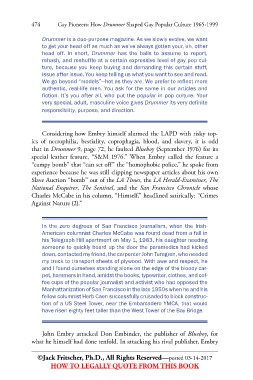Page 492 - Gay Pioneers: How DRUMMER Magazine Shaped Gay Popular Culture 1965-1999
P. 492
474 Gay Pioneers: How Drummer Shaped Gay Popular Culture 1965-1999
Drummer is a duo-purpose magazine. As we slowly evolve, we want
to get your head off as much as we’ve always gotten your, uh, other
head off. In short, Drummer has the balls to assume to report,
rehash, and reshuffle at a certain expressive level of gay pop cul-
ture, because you keep buying and demanding this certain stuff,
issue after issue. You keep telling us what you want to see and read.
We go beyond “models”—hot as they are. We prefer to reflect more
authentic, real-life men. You ask for the same in our articles and
fiction. It’s you after all, who put the popular in pop culture. Your
very special, adult, masculine voice gives Drummer its very definite
responsibility, purpose, and direction.
Considering how Embry himself alarmed the LAPD with risky top-
ics of necrophilia, bestiality, coprophagia, blood, and slavery, it is odd
that in Drummer 9, page 72, he faulted Blueboy (September 1976) for its
special leather feature, “S&M 1976.” When Embry called the feature a
“campy bomb” that “can set off” the “homophobic police,” he spoke from
experience because he was still clipping newspaper articles about his own
Slave Auction “bomb” out of the LA Times, the LA Herald-Examiner, The
National Enquirer, The Sentinel, and the San Francisco Chronicle whose
Charles McCabe in his column, “Himself,” headlined satirically: “Crimes
Against Nature (2).”
In the zero degrees of San Francisco journalism, when the Irish-
American columnist Charles McCabe was found dead from a fall in
his Telegraph Hill apartment on May 1, 1983, his daughter needing
someone to quickly board up the door the paramedics had kicked
down, contacted my friend, the carpenter John Turngren, who needed
my truck to transport sheets of plywood. With awe and respect, he
and I found ourselves standing alone on the edge of the bloody car-
pet, hammers in hand, amidst the books, typewriter, clothes, and cof-
fee cups of the popular journalist and activist who had opposed the
Manhattanization of San Francisco in the late 1950s when he and his
fellow columnist Herb Caen successfully crusaded to block construc-
tion of a US Steel Tower, near the Embarcadero YMCA, that would
have risen eighty feet taller than the West Tower of the Bay Bridge.
John Embry attacked Don Embinder, the publisher of Blueboy, for
what he himself had done tenfold. In attacking his rival publisher, Embry
©Jack Fritscher, Ph.D., All Rights Reserved—posted 03-14-2017
HOW TO LEGALLY QUOTE FROM THIS BOOK

